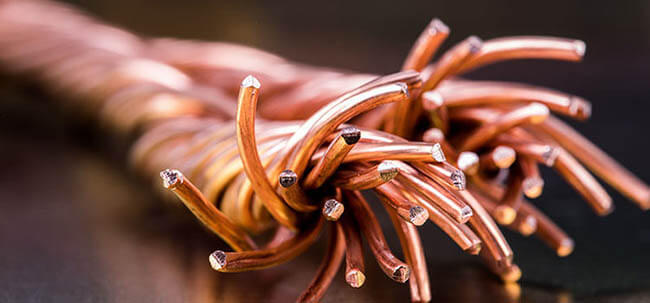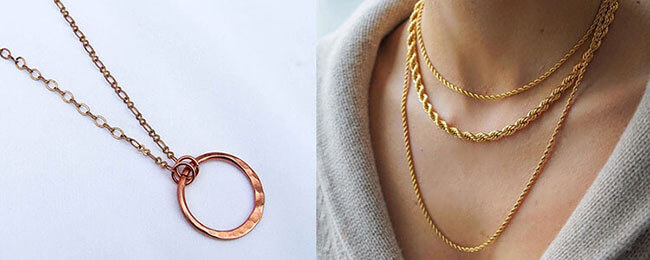The unusual resemblance between copper and brass has sparked an important debate in the manufacturing industry. But actually, there are many differences between brass and copper in the aspect of color, price, hardness, strength, etc. Here, I have a detailed analysis of the two materials individually and collectively, and you’ll be sure to benefit from it a lot.
1. What is copper?

In the words of USGS, copper ranks as the third most used metal for commercial purposes. It is one of the very first metals to be found and used by mankind because copper exists in its natural and pure state.
Characteristics of Copper
The diverse use of Copper can be owed to the following characteristics:
- It is a soft metal
- It is ductile and malleable
- Originally, it has a reddish-orange color
- It is an excellent conductor of electricity
*Malleability is the ability of a metal to be drawn into a thin sheet, whereas ductility is the ability of a metal to be rolled into a thin wire.
Uses of Copper
Copper is usually used in a number of industries today. Here are some of the uses of copper to be considered:
- It is used in the making of tools and weapons such as arrows and chisels.
- Being a good conductor of electricity and heat, it is used in wiring.
- It is also used in construction, such as roofing.
Although Copper is directly eligible for processing, it is also used by adding other elements so that copper used to manufacture products may not be pure copper.
2. What is Brass?
To achieve specific results such as improved malleability over copper, copper alloy is produced. Brass is a kind of copper alloy that has a hint of zinc in it. This is the most common reason why people confuse brass with copper.

Composition of brass
The composition of brass is very essential to understanding its properties. Brass, along with copper and zinc can also contain other elements, such as:
- Tin
- Iron
- Lead
- Aluminum
- Silicon
- Manganese
With the change in the metal, the properties of brass change as well. Depending on the metal used, brass generally reflects these characteristics:
- If the alloy contains zinc, brass shows ductility and strength
- If the percentage of Zinc goes higher, brass becomes more malleable and ductile and vice versa
- The color of brass ranges from red to yellow, again, depending on the zinc used.
Uses of brass
Brass has a gold-like color giving it an aesthetic appearance. Due to its appearance, Brass is commonly used for decorative purposes such as jewelry, the zippers of jeans, and pants. It can also be used to make musical instruments, as well as locks, valves, ammunition, and plumbing components.
3. Copper vs Brass
To see the differences between both materials, here is a head-to-head comparison of copper and brass.
Composition
When compared in light of element composition, copper is a pure metal whereas brass is a Copper-Zinc alloy. The element composition of brass is diverse and the properties can vary according to the alloy form. The most common brass alloy is composed of copper and zinc as base metals. Some other metals are aluminum, manganese, and lead.
Hardness
The hardness of a metal can be used to refer to its resistance against deformation in the geometry under a certain amount of force, in the simplest words.
While drawing a comparison of brass and copper, brass is harder and stronger than copper. The reason is that brass is an alloy and the hardness is improved due to the presence of Zinc in it. On the hardness scale, it lies anywhere between 3 to 4. Whereas copper ranges from 2.5 to 3 on the metal hardness chart.
Corrosion Resistance

Pic source:Jewelrymakingjournal
Copper behaves like a noble metal, hence it is non-corrosive. Usually, copper is found with a protective coating on it, named a green patina. If the coating of Cuprous oxide is ruined, it can cause corrosion.
Similar to copper, brass is also a non-corrosive metal. Therefore, it is used in damp areas or aggressive environments. All in all, brass is more corrosion-resistant than copper.
Melting Point
The melting point or temperature is a major determining factor of the properties of metals. It can be defined as the equilibrium between two states of matter – solid and liquid. When the metal changes from the solid state to liquid, the use of the metal is varied.
When compared, the melting point of copper is 1085 degrees Celsius whereas that of brass is dependent on the percentage of zinc used. On average, it ranges from anything between 900 to 940 degrees Celsius.
Thermal Conductivity
When the electrical conductivity of both is compared, copper is more conductive. Electrical conductivity is the measure of metal to pass electricity.
The reason why copper is more conductive lies in the fact that it has no electrical resistance and hence no barrier to limit the flow of electricity. Therefore, copper is widely used in electrical wires. Comparatively, being a mixture of copper and zinc, brass is 72% less conductive than copper.
Electrical conductivity
When the electrical conductivity of both is compared, copper is more conductive. Electrical conductivity is the measure of metal to pass electricity.
The reason why copper is more conductive lies in the fact that it has no electrical resistance and hence no barrier to limit the flow of electricity. Therefore, copper is widely used in electrical wires. Comparatively, being a mixture of copper and zinc, brass is 72% less conductive than copper.
Here is the brief summary for you to have a quick look,
|
Property |
Copper |
Brass |
|
Color |
Reddish-brown |
Yellow, golden, silver, reddish-gold |
|
Affordability |
More expensive |
Less expensive |
|
Melting Point |
1085°C |
900-940°C |
|
Use |
Cables, wires |
Door knobs, jewelry, valves, nuts |
|
Ultimate tensile strength |
220 MPa |
360 MPa |
|
Yield Strength |
33.3 MPa |
34.5 to 683 MPa |
4. How to Tell the Differences Between Copper and Brass?
Many people have trouble distinguishing between different metals and also the items made from them. If you’re unsure about a metal object, there are a few options for testing it:
Compare with other copper items
Compare the item to one that you are certain is copper. Place them next to one another and compare the colors and sounds to see if there are any parallels or differences.
Examine the color
Examine the color of the object with care. If it’s copper, it should be a reddish-brown color with areas of green if it’s corroded. Brass, on the other hand, should take on a more yellowish hue following corrosion and turn a darker brown color.
Check the hardness
Give the item a firm tap with your fist and pay attention to the sound it makes. Copper is a softer metal, thus it should provide a more mellow and round sound.
Examine the surface
Examine the item’s whole surface, both inside and out, for any indications that would indicate its material of origin. Brass is commonly branded with the letter C followed by a set of three to five numerals, although copper is not usually marked.
5. Which Material is Better for Jewelry?
Both copper, and brass have been in the jewelry industry since the beginning. Doubtlessly, their eye-pleasing appearance and durability have made them one of the most used metals.
However, before you get to buy some pieces for business or yourself, you must have the know-how of whether brass or copper is better.
Copper has a reddish-brown color that is good if you are looking for some antique pieces. Copper has been used in the jewelry industry as it is a pure metal and is super easy to mold and shape. Moreover, the purity of the metal helps to imprint various designs on it as well.
In comparison to copper, brass has a bit of a gold-like appearance. This being the reason, brass is quite famous for jewelry. Often, the manufacturers add another metal to the Copper-Zinc alloy in order to enhance the already-existing features of the metal.
Comparison

The most common things one sees before buying jewelry are design, durability, and color. Therefore, both of the metals can be good in different ways. Here is a quick comparison between both:
|
Parameter |
Copper Jewelry |
Brass Jewelry |
|
Design |
Versatile |
Not Versatile |
|
Base Color |
Reddish-brown |
Gold-like (may vary) |
|
Durability |
Poor |
Better |
|
Price |
More expensive |
Less expensive |
How to choose the right one?
As mentioned above, in terms of color, brass has a slight edge over copper. The reason is, people find it as an affordable alternative to gold. Therefore people love buying brass to replace gold.
Whereas, when compared in terms of design, copper has more to offer. Copper is a softer metal than brass, therefore, it can be molded easily into different shapes. On the other hand, brass is not a soft metal and does not show versatility in designs. People who adore the different designs of jewelry, usually go for copper.
Finally, copper is a soft metal so it is less durable. In comparison, although brass itself is not a highly durable metal, the manufacturers add some amount of other metals such as tin in it. It increases the durability of the metal. If you are someone who prefers durability over design and versatility, brass will be the best for you.
Besides, whichever jewelry you wish to buy for business or personal use, make sure that you are storing them in a better place. If you are not treating them right, they might change their color. Moreover, while you are wearing the jewelry, apply a thin layer of moisturizer on your skin to avoid the reaction. Otherwise, it will leave a green impact on your skin.
In the End
If you have benefited a lot from this blog, share it with your friends or on Facebook, Reddit, Twitter, Quora, etc.
We’re Jingsourcing, a leading sourcing company in China. We can help you wholesale and customize different styles of jewelry made of various materials including brass and copper. If you need help, feel free to CONTACT US.

Leave A Comment